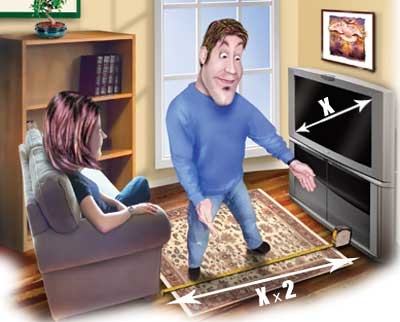Back to Basics: How to Set Up Your new HDTV Page 2
Getting to the SourceHigh-definition TVs come in two varieties - monitors and integrated sets. HDTV monitors require an outboard digital tuner to receive high-def signals, whereas integrated sets have an HDTV tuner already built in. (Most HDTVs are now integrated sets.) You can get HDTV signals in three ways: via an off-air antenna, an HDTV cable box, or an HDTV satellite receiver.  The distance between your HDTV and your viewing position should be at least twice the screens diagonal measurement.
The distance between your HDTV and your viewing position should be at least twice the screens diagonal measurement.
Off-air antennas, which provide access to local HDTV broadcasts, come in indoor and outdoor versions. AntennaWeb.org is the best place to start looking for an antenna. Enter your address, and the site tells you where high-def stations are located in relation to your house and what kind of antenna you need to pick them up. For example, you might need to put a medium or large directional antenna on your roof if you live in a one-story house surrounded by taller buildings, while a smaller multidirectional antenna might do the job for a multistory house on a property free of obstructions. Consider an indoor antenna if you live in an apartment building that won't let you have an outdoor antenna, or if you don't want one on your roof.
HDTV cable boxes and satellite receivers are similar to their non-HD counterparts but have additional connections and features to provide high-def programming. Some new models even include a hard-disk drive, which gives you TiVo-like functions such as automatic recording of favorite TV shows and pausing live TV.
Some new integrated sets have a CableCARD slot. The credit-card-size CableCARD, which is furnished by your cable provider, lets you connect the cable feed directly to the TV and tune in premium channels you've subscribed to without having to install a cable box. Of course, if your cable or satellite service doesn't carry all of your local HDTV stations, you'll probably want to add an off-air antenna so you can receive them.
You have many options for making the video connection between an HDTV tuner and monitor. The most common is to run component-video cables from the set-top tuner box to the TV. Or you could instead run the cables to an A/V receiver and then make a component-video connection from the receiver to the TV. This is more convenient if you want to use the receiver to switch between other component-video sources, like your DVD player.
Important: When making high-def component-video connections through a receiver, make sure the receiver can handle the wider bandwidth of HDTV signals, or you'll lose picture detail. The receiver's manual or product literature will typically refer to these connections as "wide-bandwidth," "HDTV-compatible," or just "wideband." Also, make sure your installation hardware -cables, splitters, and other components such as signal amplifiers - can handle the full HDTVbandwidth. Your hardware should have a bandwidth of at least 110 megahertz (MHz) to ensure that there's no degradation of the HDTV signals passing through it.
Most HDTV tuners also have an HDMI (High-Definition Multimedia Interface), or possibly a DVI (Digital Visual Interface) output, which provides a top-quality, all-digital video connection. To use it, your HDTV monitor has to have an HDMI input or a DVI input that's compliant with the standard HDCP (High-bandwidth Digital Content Protection) copy-protection scheme. (HDCP uses a transmitter and receiver with encryption at each end to pass programs from a tuner to a TV.) HDMI, which normally incorporates HDCP, is basically an upgraded version of DVI that can handle both audio and video. Some HDTV tuners and sets also include an analog VGA jack for connection to a computer. Another connection - RGB+H/V (red, green, and blue plus horizontal and vertical sync signals) - is found mostly on high-end front projectors.
Once you connect the tuner, you'll need to set it to match your TV's display format. There will be a switch or menu option for selecting 720p or 1080i output, depending on your set's native resolution. Flat-panel LCD and plasma TVs often have a different native resolution - such as 1,024 x 768 - in which case the set will convert the signal as needed. If you're not sure what display format your TV uses, check the manual.
And don't forget the audio! If you have an A/V receiver, run either an optical or coaxial digital audio cable (depending on your equipment) from the cable box or satellite receiver to the A/V receiver for 5.1-channel surround sound. If you don't have an A/V receiver, connect the tuner and TV using standard analog stereo inputs and outputs. Note that in addition to the high-def video, the HDTV signal includes Dolby Digital audio - in 5.1 channels if that's how it was broadcast or else in Dolby Digital stereo.
Most cable and satellite installations have to be done by professionals, because the set-top box will need to be configured and activated. With a satellite hookup, you'll also need an 18- to 20-inch dish to receive HDTV. If you already have satellite service, you'll at least need a new receiver. With DirecTV, you'll also need a larger, elliptical dish. Most people can handle hooking up an off-air antenna, but placing an outdoor antenna on the roof or a tall mast might require a professional.
- Log in or register to post comments



































































